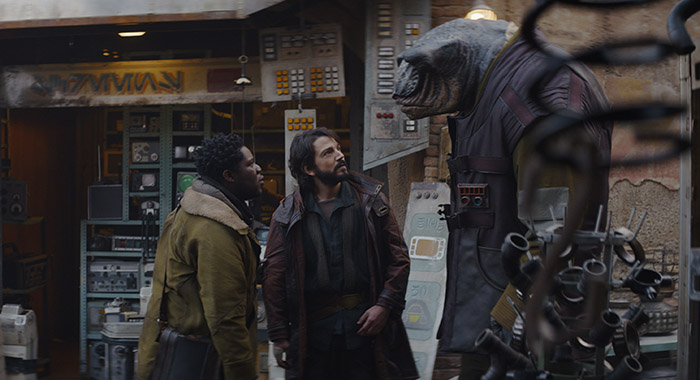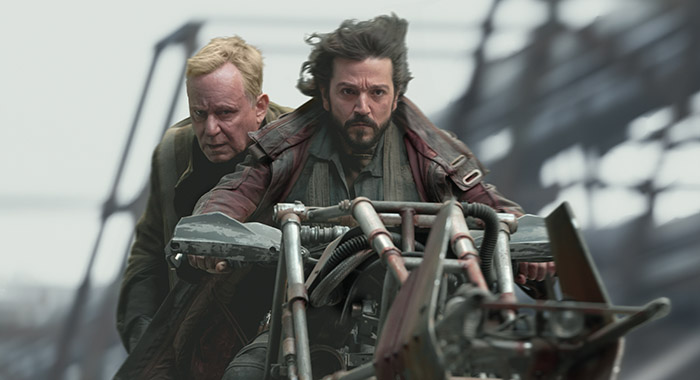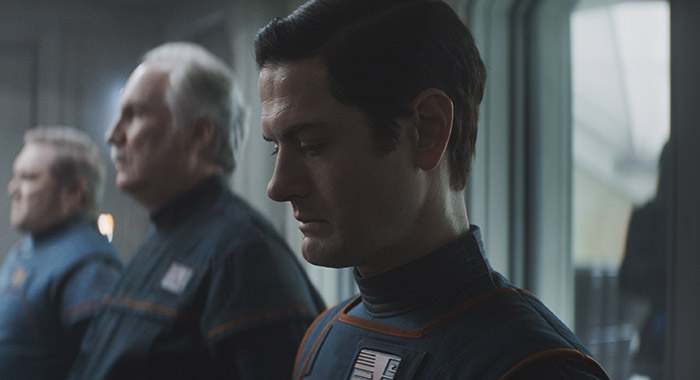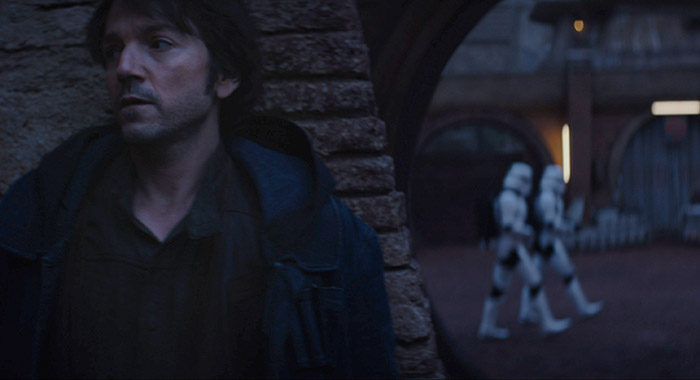TAGGED AS: Disney, Sci-Fi, science fiction, streaming, television, TV
The first three episodes of Andor are out in the wild, streaming on Disney+, and the program clearly continues the viewpoint of Rogue One: A Star Wars Story and the show’s executive producer, Tony Gilroy, who wrote the film. The galaxy here, however, is a little colder, grayer, and wetter. The streets and gantries Cassian Andor (Diego Luna) walks are grimier and, somehow, more complicated than the mainline Skywalker Saga. His is a world where the good guys can do bad things, the Empire is not a monolith, and (so it seems) even a kidnapping can lead to a net good.
And though the first three episodes represent a nearly complete adventure, it is only the beginning of Cassian’s journey. We may know the end of his path, but as the following analysis of the debut episodes illustrates, there is still plenty to discover about the title character and his relationship to the galaxy far, far away.
Spoiler alert: The following reveals details about the first three episodes of Disney+ series Andor. If you have not watched the episodes and want to avoid spoilers, stop reading here.

(Photo by Lucasfilm Ltd.)
In the end, it was a smart choice to debut the program with the first three episodes. Although we’re reluctant to say it felt like a movie, the episodes certainly feel like a single unit of story. As Gilroy put it back at Star Wars Celebration, the episodes cover “the worst day” of Cassian’s life and a pretty good reason to enlist with an apparent Rebel — it means a quick way off of Ferrix — but the plot point may not have been as effective had these first episodes been released across three weeks.
Certain questions we had in the first episode — like whether or not Bix (Adria Arjona) was also Kenari and if Cassian had the part he offered her contact — are quickly answered in the subsequent installments. Would those questions have proved more intriguing if we had to wait an extended period of time to learn the answers?

(Photo by Des Willie/Lucasfilm Ltd.)
Meanwhile, the way these three episodes work as their own story arc suggests the rest of the season will do the same, with the next three concerning wherever Luthen Rael (Stellan Skarsgård) takes him and the remaining six episodes after that also breaking into three-episode increments. Sure, each episode leads Cassian closer to become a true Rebel agent, but building it in four three-episode arcs comes with a certain aesthetic satisfaction.
George Lucas’s initial idea for an extended story universe consisted of a 12-film cycle; although, as details of his quickly-sketched plan emerged, it became clear that the idea more resembled the James Bond pictures than a tightly-plotted saga with every fourth film devised as, essentially, a Star Wars Story to fill in info on the Jedi and other aspects of the universe. Based on all the available material on the subject, what we now call “The Skywalker Saga” didn’t come into crystal clear view until the 1980s. At that point, largely thanks to the Original Trilogy, the notion of a three-episode structure seemed the most natural way to plan a Star Wars tale — or, really, any film saga. Thus, the saga was expected to be a trilogy of trilogies.
So, we’re not overly surprised Andor is utilizing a similar structure, but we may have to wait until episode 6 to determine if the first season is using the format effectively.

(Photo by Lucasfilm Ltd.)
Although various Star Wars Expanded Universe novels and video games have explored the presence of corporate entities in the galaxy (Star Wars: The Last Jedi also alludes to them being the real winners in a prolonged conflict), Andor feels like the first time the relationship between private companies and the Empire is really being explored (although, it is always possible Star Wars Rebels touched on this as well). As Sgt. Linus Mosk (Alex Ferns) says in episode 2, “Corporate Tactical Forces are the Empire’s first line of defense.” That is a very compelling new wrinkle to the Imperial Era.
As established in episodes 1 and 2, Ferrix is in the Morlani system, a part of the Preox-Morlana Corporate Zone. The Preox-Morlana Corporation, apparently headquartered on Morlana One, not only mines resources for the Empire, but acts as an administrative and law enforcement body on the Empire’s behalf within the zone. This is a fairly new approach for Star Wars, where Imperial garrisons are plentiful and Emperor Sheev Palpatine (Ian McDiarmid) enjoys showing off the might of his army. It nevertheless reflects an understandable reality within Imperial rule; why send all the necessary personnel, munitions, supplies, and officers to patrol a work site when the company directly in charge of the work will do it for you? As the Empire is an acknowledged fascist state, its close ties to industry should be a bigger deal. And though Syril Karn (Kyle Soller) botches his big operation on Ferrix, it will be interesting to see if the Imperial Security Bureau follows up on his hunch about Cassian.
Also, it should be said, that Karn is the worst kind of fascist: a true believer. Or, at least, the first three episodes suggest to us that he truly believes in the concept of order as outlined by Imperial propaganda. As we mentioned in our Andor preview, Soller said there is a “question mark” over the character’s head, and his apparent devotion to the Empire could curdle across the series.

(Photo by Lucasfilm Ltd.)
Another good thing about releasing three episodes at once: we get the full picture of Kassa’s (Antonio Viña) departure from Kenari.
As Fiona Shaw, who plays retired scrapper Maarva Andor, mentioned when Rotten Tomatoes spoke to her about the series, “We begin to understand that she is Cassian’s mother. But, of course, they’re a strange pair because she wasn’t always Cassian’s mother.”
And while it is unclear if we’ll get more flashbacks to their time together on Ferrix, the circumstances of Kassa’s displacement from Kenari is a big deal for his older self, as evidenced by the search for the sister he left behind.
It leads to a couple of big questions: What happened on Kenari? And why are people from that world so unusual? At Celebration, Gilroy said Cassian’s homeworld was strip-mined by the Empire — or was it the Preox-Morlana Corporation? — and that the series would begin with Cassian seeing his second world colonized in a similar manner. Also, was Kassa part of a kidnapping somehow turned good?
From the glimpses we saw in the flashback, Kenari seems to be devoid of adults — perhaps they all went to fight in the Clone Wars? That conflict is clearly still happening when Maarva and Kassa meet. The ship they both investigate happens to be filled with CIS (or Separatist) soldiers who appear quite willing to kill the local population. Then again, so do the Republic soldiers — and even Maarva and her husband, Clem Andor (Gary Beadle), for that matter! But considering it is a CIS ship that crashes, will the Old Republic cruisers in orbit turn around and just firebomb the planet to eliminate any perceived threat? Will that leave Kassa as the presumed only survivor of Kenari, who happens to dislike the Republic and the Empire?
We asked Shaw if Maarva senses a difference between the Republic and the Empire. She said, “There’s always somebody annoying them, and they don’t really care what the name of person who is annoying them. Somebody is interfering with their freedom.”
So, it is possible any galactic government will be met with the same disdain by both Andors. But does it mean the Republic committed some sort of war crime above Kenari? We doubt Gilroy would ignore the possibility, but the more likely answer is an eventual appearance by Imperial Star Destroyers in the Kenari system during the 15-year gap between the flashbacks and the present-day story.

(Photo by Lucasfilm Ltd.)
Meanwhile, Kassa grew up to be the exact sort of man Luna suggested he would be — someone incapable of the sacrifice he ultimately makes. Although Luna’s charm makes him inherently likable, Cassian is a troubled young man. As Arjona suggested at the D23 Expo two weeks ago, there is some unpleasant history between Bix and Cassian despite her willingness to help him. It is clear he owes nearly everyone in town something, be it credits or a favor.
“No mother would be pleased if their son doesn’t pay back the money [he owes],” Shaw said of the man we meet in these first episodes. “I think she’s vulnerable because he tells her one thing and she feels it’s not entirely the truth. She doesn’t know who knows what.”
She also noted that while Maarva instigated the original lie — that he is not from Kenari — to protect him, it’s Cassian’s attempt to find out the truth about his sister that leads to their troubles in the first trio of episodes.
“There are all these circles of trust, which is very much what the series is about. It’s about trust and distrust, betrayal, shock of betrayal, and the hope that some good values can exist in between all of that,” she added.
But beyond those obvious differences in the character between film and series, there is one other thing we want to point out about Kassa of Kenari: killing Preox-Morlana security officer Verlo (Stephen Wight) messed him up. It is a huge contrast from the callous way he offs his contact in Rogue One, and we think his regret about the incident will inform him for the next nine episodes. At some point, he will pivot, and we expect that change will be one of the most tragic things about him.
Also, we can’t help but think Kenari is, in some way, a tip-of-the-hat to Kenner, the former Cincinnati-based toy company that made Star Wars toys throughout the late 1970s and ’80s.
To wrap up this exploration of Andor‘s first three episodes, we have a few newly-arising questions and some observations:
— While we may not meet K-2SO (Alan Tudyk) this season, Cassian’s rapport with droids is established via Maarva’s helpful assistant, B2EMO (Dave Chapman), an interesting character as it has reservations about lying to Maarva about Cassian’s whereabouts and activities. Is K-2’s candor ultimately the result of working for a constant liar?
— Why doesn’t Kassa like his own reflection? It is easy to think why Cassian might dislike his own visage, but what could he have done as a boy to inspire such self-loathing? As mentioned in Rogue One, Cassian has been in the fight since he was eight, so it is possible Kassa has already committed some dark thing that can only be righted by an ultimate sacrifice.
— Did Timm Karlo (James McArdle) deserve to die? Sure, he was jealous of Cassian’s casual way with Bix and suspicious of the guy’s intent. Sure, he called down the fire from Preox-Morlana security. Also, he seems to treat Bix as possession more than a person. But was it necessary to kill him? Consider this more of a philosophical brain teaser about Star Wars morality.
— In episode 2, Bix takes off her jacket in a suggestive manner and is seen dressing the morning afterward. It is a surprising depiction of intimacy in the Star Wars universe, which tends to tone down physicality (certain kisses notwithstanding) for something more ethereal. It is consistent, though, with Gilroy’s assertion that his characters are fully-drawn characters.
— Episode 1 features the first on-screen use of the BBY (Before the Battle of Yavin) calendar in a live-action Star Wars project. It is particularly useful here as it is, essentially, a countdown clock to Rogue One, which happens in close proximity to the original Star Wars film and its climatic Battle of Yavin.
— The interesting juxtaposition of Cassian’s exploits as a young adult with Kassa’s misadventures as a child and Rael and Maarva taking Kassa off-world suggests the past 15 years of his life marked the start of a sort of second childhood. It also suggests that childhood is well and truly over.
![]() 96%
Andor: Season 1
(2022)
new episodes premiere on Wednesdays on Disney+.
96%
Andor: Season 1
(2022)
new episodes premiere on Wednesdays on Disney+.